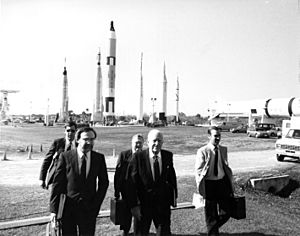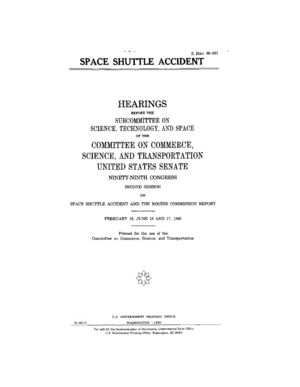Rogers Commission Report facts for kids
The Rogers Commission Report was a special report created by a group called a Presidential Commission. This group was given the important job of finding out what happened during the Space Shuttle Challenger disaster. This terrible event happened during the shuttle's tenth mission, known as STS-51-L.
What the Report Found
The Rogers Commission finished its report and gave it to President Ronald Reagan on June 9, 1986. The report explained exactly what caused the disaster, which happened just 73 seconds after the shuttle took off. It also strongly suggested that NASA (the space agency) should make big improvements. These improvements included adding new safety features to the space shuttles and changing how NASA managed its future space missions.
Who Was on the Commission?

The Rogers Commission was made up of many important and knowledgeable people. They were chosen to help figure out what went wrong and how to prevent similar accidents in the future. Here are some of the key members:
- William P. Rogers: He was the chairman, meaning he led the group. He had been a very important government official before, serving as the United States Secretary of State and the United States Attorney General.
- Neil Armstrong: He was the vice chairman. You might know him as the first human to ever walk on the Moon during the Apollo 11 mission.
- David Campion Acheson: A diplomat, which means he worked with other countries.
- Eugene E. Covert: An expert in aeronautics, which is the science of flight.
- Richard P. Feynman: A brilliant scientist who won the Nobel Prize in Physics in 1965. He was a theoretical physicist, meaning he studied the basic laws of nature.
- Robert B. Hotz: The editor of a well-known aviation magazine called Aviation Week And Space Technology.
- Donald J. Kutyna: An Air Force general with experience in missiles and managing space shuttle programs.
- Sally K. Ride: An American engineer and astrophysicist. She was also the first American woman to travel into space, flying on the Challenger for missions STS-7 and STS-41-G.
- Robert W. Rummel: An executive from Trans World Airlines and an aviation expert who advised NASA.
- Joe Sutter: An engineer for Boeing who was part of the team that designed the famous Boeing 747 airplane.
- Arthur B. C. Walker, Jr: A scientist who studied the Sun and a professor at Stanford University.
- Albert D. Wheelon: A physicist who helped create the Central Intelligence Agency's aerial surveillance program, which uses planes to watch things from above.
- Charles E. Yeager: A retired Air Force general who was the first person to fly faster than the sound barrier.
- Alton G. Keel Jr.: He was the executive director, helping to manage the commission's daily work.
Images for kids



